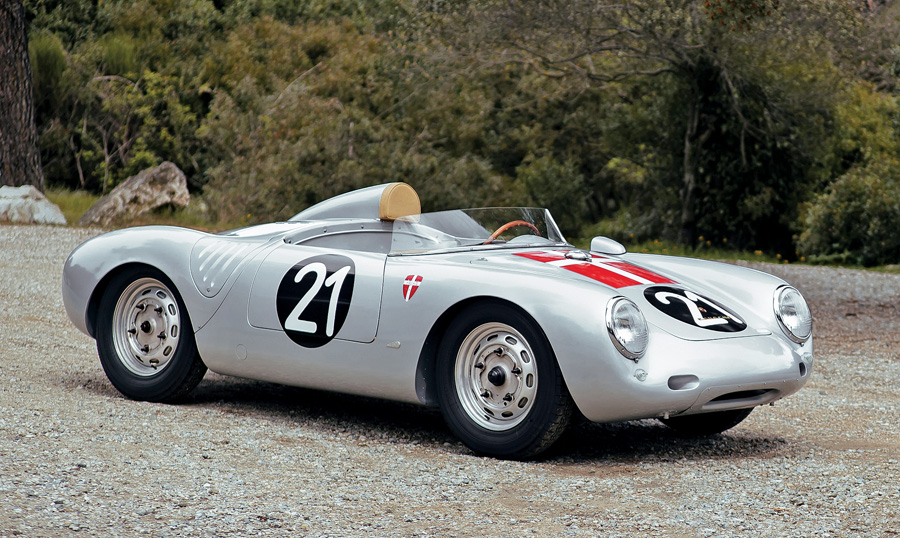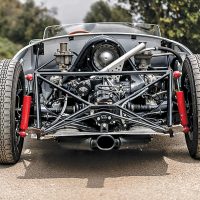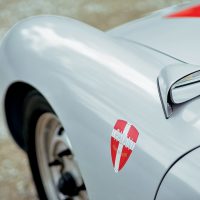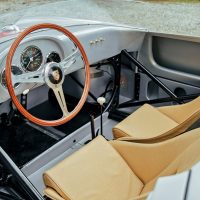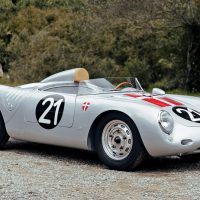SCM Analysis
Detailing
| Vehicle: | 1957 Porsche 550A Spyder by Wendler |
| Years Produced: | 1956–57 |
| Number Produced: | 37 |
| Original List Price: | $6,800 |
| SCM Valuation: | $4,900,000 |
| Chassis Number Location: | Welded tag on rear chassis cross tube |
| Engine Number Location: | Front top of case |
| Club Info: | Porsche 356 Club |
| Website: | http://www.porsche356club.org |
| Alternatives: | 1955–56 Maserati 150S, 1954–57 OSCA MT4, 1955–57 Porsche 356 Carrera |
| Investment Grade: | A |
This car, Lot 140, sold for $3,781,206, including buyer’s premium, at RM Sotheby’s Villa Erba, Italy, sale on May 25, 2019.
It is difficult to think of a 1950s German racing car more iconic than the Porsche Spyders that were built between 1953 and 1961.
They were not particularly beautiful — but they were devastatingly effective. These Porsches pestered — and often defeated — much larger and technically faster cars from Ferrari, Jaguar and Aston Martin at venues all over the world. Well before Lotus was more than a twinkle in a young Colin Chapman’s mind, Porsche exploited the concept of tiny cars with small engines, minimal weight and slippery aerodynamics being an easy match in terms of horsepower and weight on all but the longest tracks.
These Porsches certainly caught the world’s imagination, as they were feisty underdogs everyone wanted to cheer for. The romantically tragic image of actor James Dean’s accident on a lonely California highway probably didn’t hurt, either, but regardless, the Porsche Spyders have been desirable collector pieces for as long as they have been around.
Going racing
Starting with mostly Volkswagen components in the late 1940s, Porsche’s new 356 sports car sold well, and the company gradually moved to Porsche-built parts. By 1952, the company was strong enough that the family decided it was time to create a purpose-built racer. There were two pieces to this project — a completely new 4-cylinder, 4-cam racing engine (Project 547), and a suitable racing car to use it (Project 550).
Ernst Fuhrmann designed an engine that was a wonder of compact, lightweight horsepower. It originally made 120 horsepower at 6,400 rpm from 1,500 cc (with low compression for the terrible gas available at the time). It weighed just over 300 pounds.
It was also insanely complicated — more of a Swiss watch that made power than a conventional engine.
The cam drive alone used nine shafts, 14 bevel gears and two spur wheels. The factory figured that an experienced builder with special tooling required 120 hours to assemble the engine, and that is with the entire roller-bearing crankshaft and rods assembly installed as a pre-built unit. Just setting the cam timing took between eight and 15 hours.
The engine was a jewel, though, and it was highly reliable after the inevitable early sorting-out issues were resolved. With only minor improvements, it became Porsche’s default racing engine well into the 1960s, when the 911 6-cylinder was developed.
Complex engine, simple car
Maybe as balance, the terrific complexity of the engine was matched by the extreme simplicity of the 550 race car as introduced in 1953.
The chassis was a simple tubular ladder frame with VW-derived front and rear suspension. The engine was mounted forward of the rear wheels in classic mid-engine configuration. A very lightweight aluminum body — carefully designed and wind-tunnel tested for minimal frontal area and drag — was mounted on top of the frame. The wheel rims were mounted directly to the brake drums for simplicity and weight.
Fighting above its weight
With incremental development over the next few years, the Porsche 550 Spyder proved to be a giant killer.
During the 1954 Carrera Panamericana — a 2,178-mile combination of mountain passes and desert straights — the finishing order was a 4.9-liter Ferrari 1st, a 4.5-liter Ferrari 2nd, and 1.5-liter Porsches 3rd and 4th.
In late 1954, Porsche started implementing its plan to build “production” 550s for sale, and customer racers started showing up on tracks around the world. Although it was expensive at about $6,800 in the United States (twice a normal 356), the only way to beat a 550 was to have another and drive it better. Sales did very well, with roughly 90 cars built.
Porsche was definitely in the race-car business.
Lighter and faster
By late 1955 it was clearly time to upgrade the 550, so for the 1956 season the 550A was introduced. It was an evolution — but a major one.
The chassis was replaced with a space-frame design that was far stiffer — and 35 pounds lighter. With higher mounting points on the chassis, the body panels could be hung rather than stood, which allowed lighter bodywork, so the 550A weighed 200 pounds less than the 550.
The rear suspension was substantially revised, improving both grip and stability on the limit. Larger brakes and other details made the new car appreciably faster and friendlier than the earlier versions. Porsche sold 37 550A cars in 1956 and 1957 before replacing it.
The replacement was called the Type 718RS, but was in fact just a continuation of the concept with evolutionary changes. The RSK was built in 1958–59. It then became the RS 60 and RS 61 before its replacement by the all-new 904 in 1962. All in, there were close to 200 Spyders built and sold between 1954 and 1961, a significant number for a pure racing car.
The collector market
The 4-cam Porsche Spyders have always been considered something very special. While a few were inevitably lost to crashes, fires and other catastrophes, most survived to the present. That means that at least a few seem to change hands every year, and we can look for a market rather than occasional one-off sales.
An interesting detail is that all Spyders, regardless of model, seem to share a common underlying value. Museum-style collectors seem to prefer the purity of the early 550, while racers and other more-active users prefer the friendliness and speed of the later cars, but market value is driven by originality, provenance and history — not model or year.
The air-cooled Porsche market stayed relatively flat for years — and then went crazy between about 2010 and 2016, when it peaked.
Many Porsches have drifted down from that point, but Spyders, having ridden the craze up, seem to be holding value with a wide range dependent on collectibility. This is complicated somewhat by the fact that the truly great cars disappeared into long-term collections years ago and aren’t available. So the general range of cars that can be bought is from mediocre to excellent.
The current range of Spyder values is $3 million to about $5.5 million and seems stable. Buyers are willing to pay appropriate prices for a given car, but they aren’t in a panic lest they miss getting one, as there will be another soon.
Our subject car seems to have been in the “good” range: It is undoubtedly real, but it spent its life in East Africa, which isn’t great history. It was recently restored, and the catalog’s Jürgen Barth quote, “original form and all technical aspects are like it was in 1957.” does not suggest originality — only correctness. I doubt that bidders were fighting over this car, and it sold for an entirely correct price for what it is. Buyer and seller should both be pleased. ♦
(Introductory description courtesy of RM Sotheby’s.)
